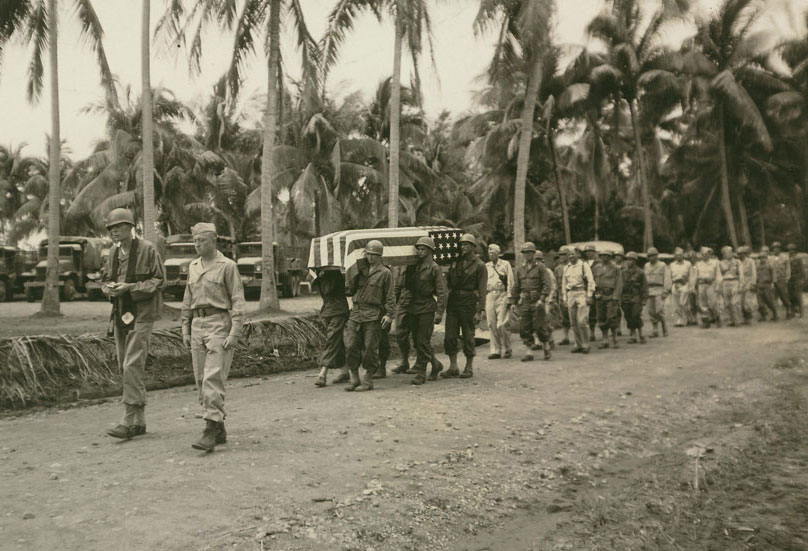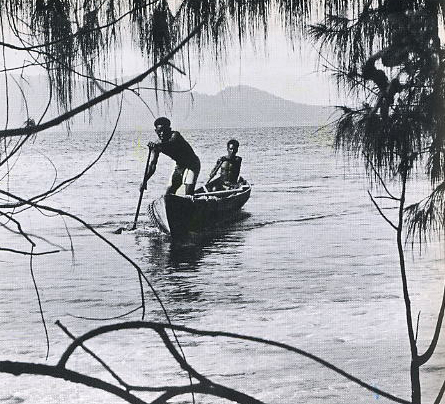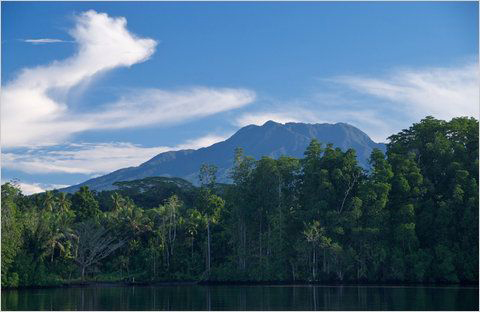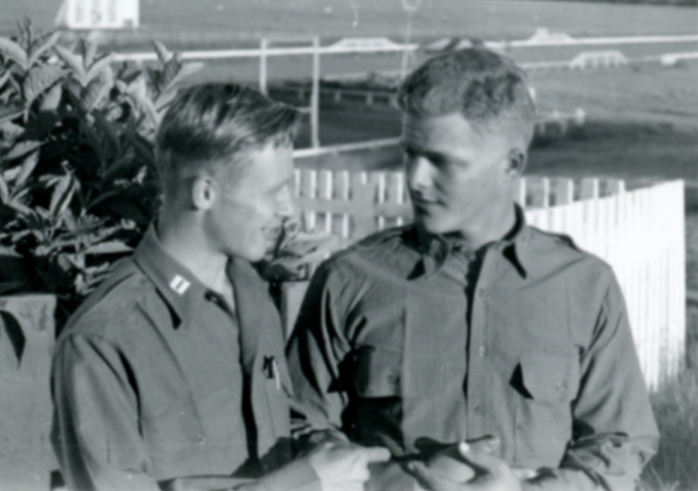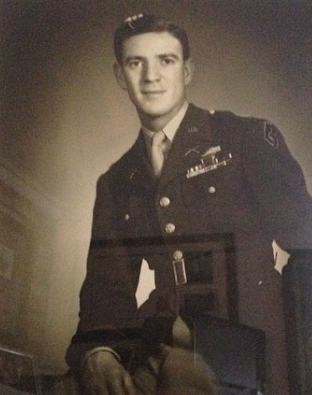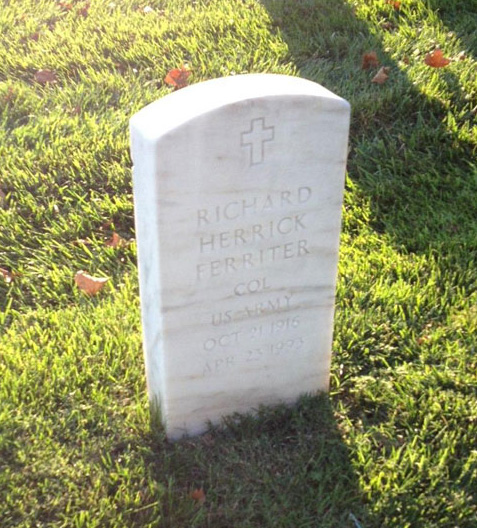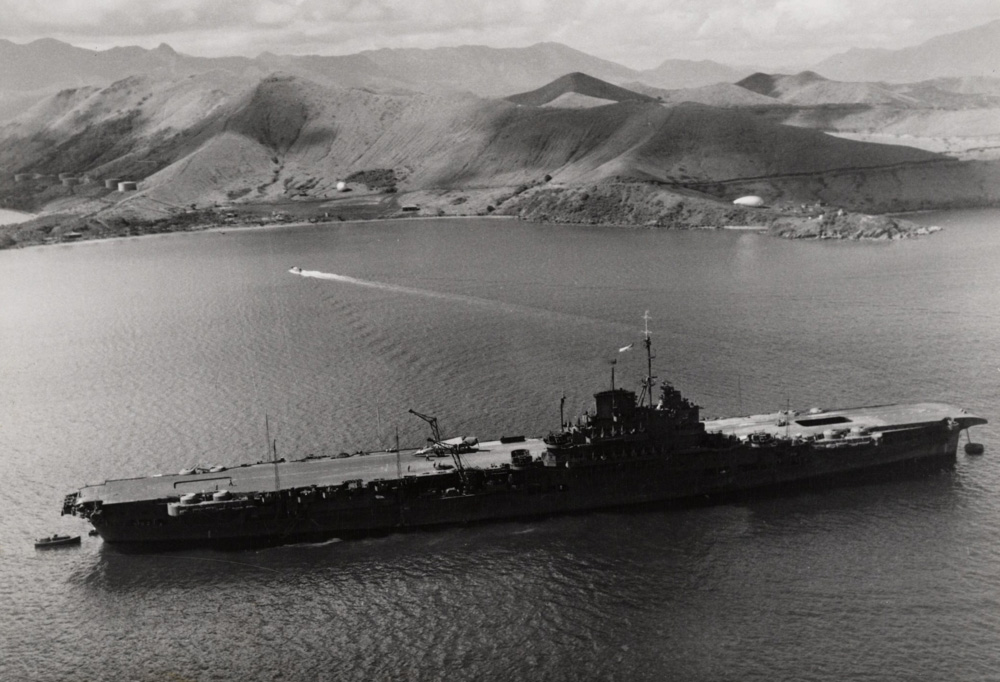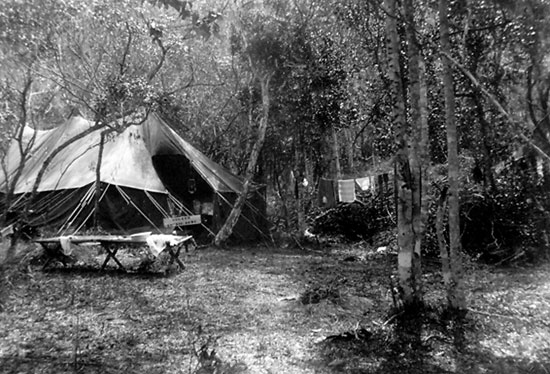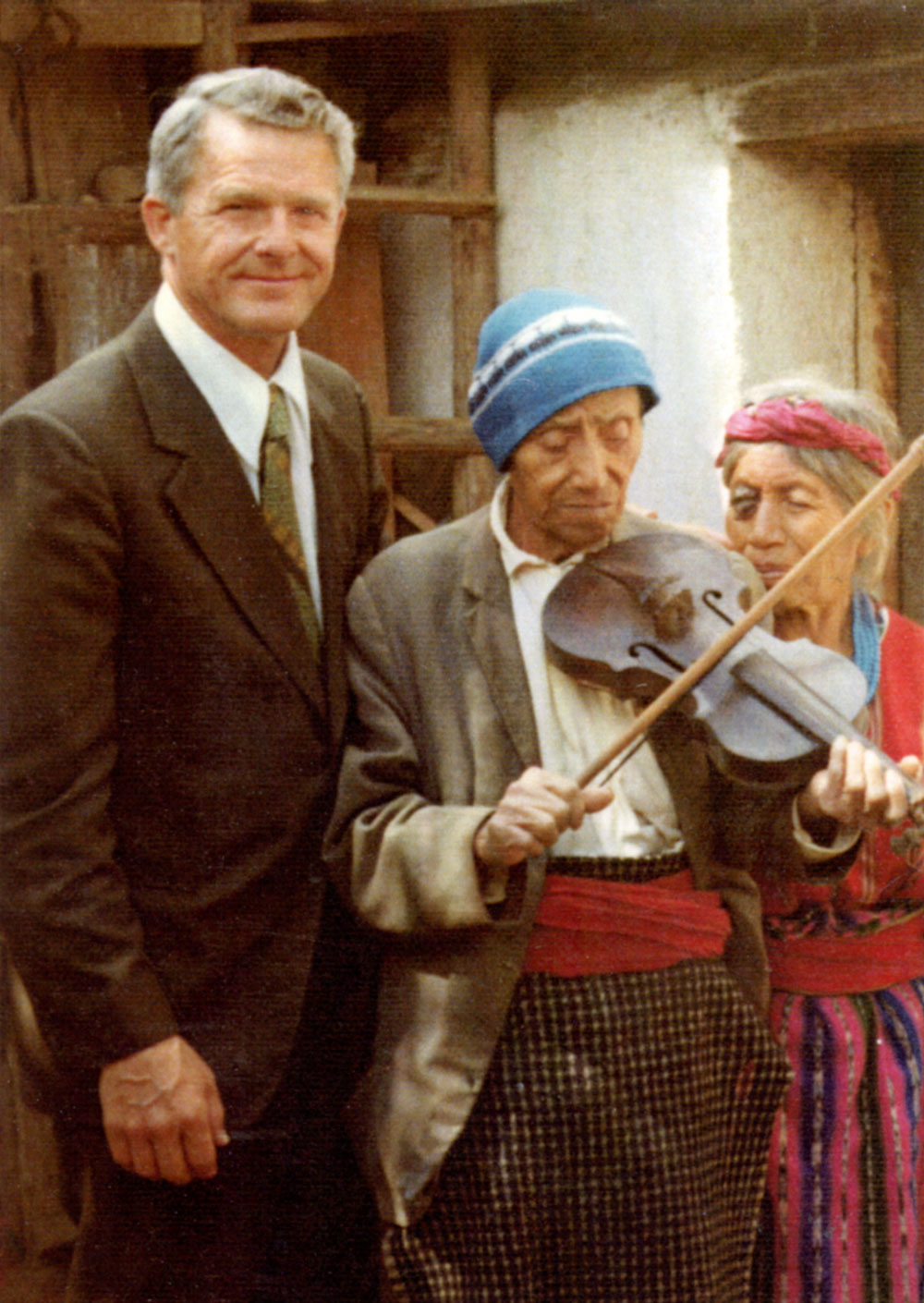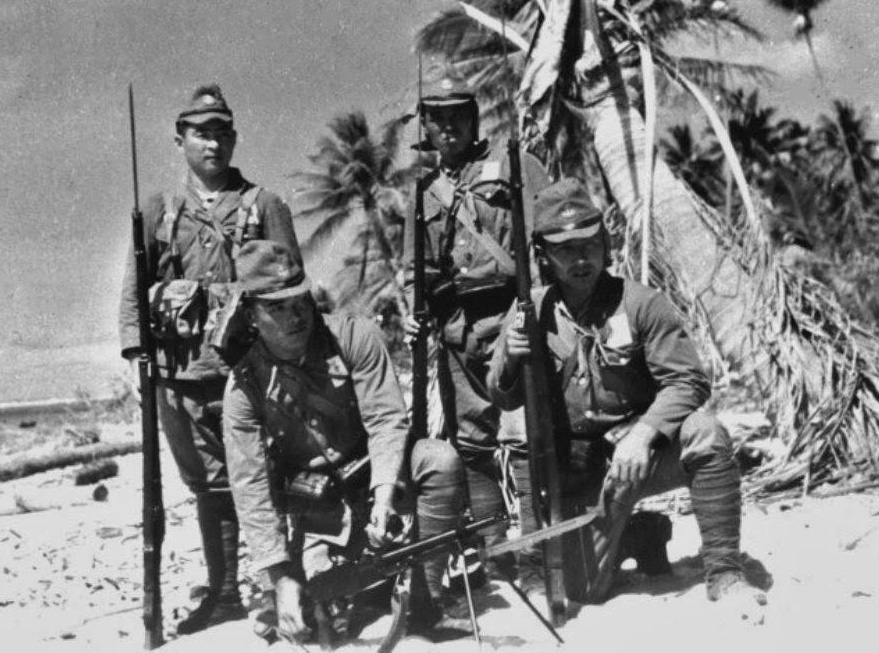Visit with Lt. Noorlander
This story begins when, as a new 2nd Lieutenant assigned to “A” Company, 35th Infantry in June, 1942, I was detailed to teach Hawaiian and Filipino sugar cane workers the rudiments of scouting, patrolling, and anti-sabotage techniques in the evening hours following our regular duty day. My knowledge, at best, was basic, learned as a draftee during the first eight weeks of Army training (1941) and reinforced minimally at Officer's Candidate School in early 1942. The workers cooperated fully and thought it was great fun but I was serious and really benefited as later events proved.
In Noumea, New Caledonia Harbor, December 1942, one week before the regiment landed on Guadalcanal on the Solomon Islands, I was transferred from a line company to battalion headquarters and appointed the S-2, or Intelligence Officer. I received no guidance. The battalion commander stated I now supervised a six man section (untrained as I learned) and handed me a couple of maps of the projected area of operations. I was to study the maps, train the section for six days, and be prepared to initiate patrol activities as soon as we landed. For the next five days we ran and exercised aboard ship to the point of exhaustion and I tried to drill some of the fundamentals of military intelligence and techniques into their consciousness to prepare them, and myself, for the unknown. No one knew what to expect.
Because of the inexperience and/or lack of skills residing in the section I thought it incumbent upon myself during this first campaign to lead every patrol assigned by the commanders. Fortunately the regiment was not committed immediately and for the next two weeks we operated security patrols into the foothills where the real jungle began. When the order to move to contact and attack the enemy came on January 7, 1943, I believed the section ready for the real patrols; however, I continued to lead and everyday for the next three weeks I moved out against the enemy seeking information. The composition of our recon patrols was normally two enlisted men and myself with the other members remaining at the command post. There were two other combat patrols which I led and each about a reinforced platoon in size. One resulted in five enemy killed and the other 13 or more, each patrol without friendly losses.
Shortly after the official close of hostilities I was given the mission to lead an eight man patrol deep into the jungle south of Mt. Austen to find the evacuation route which the Japs had used in their withdrawal from the Bloody Ridge and Gifu strong-point battles. In effect it was a simple case of following the course of the Lunga River upstream where we located a former Marine Raider bivouac, then continuing upstream several miles where a large Jap bivouac had been located. From this point we headed north over several steep ridges tracking the former Jap trail which was marked by many hasty graves and eventually breaking out of the jungle west of Kokumbona. Since many of the important patrols had been reported to Division G-2 during the campaign my name was irrevocably tied to reconnaissance missions. I didn't learn of this until much later and in retrospect it wasn't all bad; leading a rifle platoon in the attack had its hardships.
A few months later in July the division was ordered to New Georgia (NG) to reinforce and replace the 37th and 43d Divisions which had been damaged severely. In the interi^F- I had been transferred from the 35th regiment to division hqs to assist the G-2. No sooner were we set up on NG than a requirement for a long range patrol arose to establish contact with a Marine force at Bairoko. I was given the mission and with two natives as guides we bypassed the Jap defenses and followed an old trail northward for several hours. Halfway to our objective a third native overtook us and handed me a message ordering my return to hqs at once. The next day I returned to Guadalcanal by air and joined the 35th RCT which was preparing to embark for Vella La Vella, seize the island and protect the Seabees who would build an advance airstrip. Wounded during the landing, I was evacuated to Guadalcanal and a week or so later I returned to N.G. where I rejoined the division G-2 office.
Within a week or two I was transferred to the 161st infantry at the 'request of the commander, James L. Dalton III whose troop strength had been depleted by the vicious combat of the preceding six weeks. I thought that I was to be assigned as the regimental S-2, intelligence officer, but this was short-lived since Dalton had other plans for me. At the end of September Dalton nominated me to lead a highly dangerous recon patrol, a requirement placed on the division by a higher Hqs., XIV Corps. j_He said "you are selected because you are the best qualified for the mission." One day later at Corps. Hqs. I met the two fellows who would round out the patrol; a corporal Smith and a lieutenant, Dan Noorlander, who as a platoon leader in the 161st had been instrumental through personal example in turning back Jap counterattacks just a few weeks earlier. Wounded, evacuated, and returned to duty he, too, had been nominated for the patrol. And thus came to pass — Kolombangara.
We had arrived at this point in our lives by the strange twists of fate; mine had begun on Oahu with the plantation workers and Dan arrived as a result of his heroic actions and return to duty at this particular time. Dalton believed he was sending his best officers for the mission.
The Mission
On October 1 we were briefed by the Corps G-2 and provided several aerial photomaps of the island plus a series of photos which focused on the southern part of the island where the Japs had begun construction of Vila Airfield. These latter photos revealed a series of fortified defensive positions at the shore end of the runway. Our mission was to reconnoiter the airfield and the surrounding area, locate any Jap dispositions and report on Jap activities; we were to find the Japs. It was a very short briefing ending with instructions on how to get to our jump-off area. It went something like this: "There is a small launch waiting close by Munda airfield. The coxswain will take you to a small island located about eight miles west of Kolom-bangara. Here a coastwatcher is stationed and he will provide a couple of dugout canoes and some natives you can use as guides and scouts. Report your findings to the coastwatcher for relay to this Hqs. ASAP. The a# th Infantry is alerted to send two battalions to occupy Kolombangara without delay once you report. Good luck."
We had reported to XIV Corps with minimum equipment. Our carbines, several magazines of ammunition, two canteens, a knife and spoon, a soft cap in lieu of a helmet, some rice, tea and bouillon, a compass, one pistol and a 35mm camera which I had picked up at Div. Hqs. enroute to Corps. (I do not think we wore a pack since we were traveling so light. If we carried a poncho or shelter half we would have worn them folded over our cartridge belts.)
We were driven to the beach where we met our coxswain and for the next three or four hours he maneuvered his small craft hrough narrow channels and around the waters linking Baanga, Arundel, Wana Wana and smaller islands. Meanwhile Dan and I studied the aerial photos, planned our strategy and attempted to evaluate each other and the Corporal, for soon we would be facing unknown dangers, each dependent on the others. From our study of the photos we determined that we would land on Kolomban-gara just 1000 yards west of the airfield, move inland several hundred yards, then skirt the west side of the field checking on the prepared positions shown so clearly on the photos. Next we would move to the north end of the airfield and reconnoiter an area when we thought the command and administrative functions must be located. Our landing would take place shortly before dawn. Just before darkness set in the coxswain left the protection of the northwest coast of Arundel and steered the boat towards a minute speck of land, Gomu, an island perhaps 20 x 25 yards in area and covered with coconut palms. (Future President John F. Kennedy was brought to Gomu by natives after his P.T. boat had been sunk by the Japanese.) It appeared deserted and as we came closer we saw it was protected by coral reefs. However, there was a channel and the coxswain guided the boat safely to shore. We were met by the coastwatcher, a New Zealander named Forbes Robertson and his American Corporal assistant Frank Nash, an accomplished radio operator and technician. Nash had been on the west side of Kolombangara the day before and he told us the Japs had been evacuating to the east coast but he was unsure about conditions aroundthe airfield. While the Coastwatcher was briefing us on the information, he and the natives possessed, two other natives arrived and reported that they had been very close to the airfield and no Jap activity had been seen. While Noorlander and the corporal rested I pestered the CW for information on Jap strengths, habits, security, possible locations and, if they were evacuating, where was this taking place. He pointed out pertinent points of interest on the photos and when he remarked that there was a small pier at the southern end of the airfield the thought crossed my mind--maybe this would be a good place to land, especially if the Japs had moved out. We would save many hours of cross country travel and if we did come under fire, we could escape in the dark; the dugout canoes rode very low in the water and a poor target. Later after meeting the four natives who were to paddle the dugouts and talking again with the CW, Nash and the natives who had reported the inactivity, I discarded the idea of landing to the west and decided to chance a landing at the pier. I talked to Noorlander and our corporal about the change and they agreed. It was decided that one dugout, mine, would land first with the other, Noorlander and the corporal would stand off shore a hundred yards or so prepared to disappear if gun fire erupted. Our original plan would then be implemented.
The Target
Sometime around 0200 on October 2, we stepped into our two dugouts, each with two native paddlers and headed across the channel.
The Patrol
The natives paddled swiftly and as we came closer to Kolom-bangara we strained our eyes looking for any lights on shore and our ears for the sound of activity such as vehicular movement. For the last mile our dugouts weren't more than 200 yards off shore and as we approached the small pier, dawn not yet breaking, the tension was unimaginable. Quickly the two natives moved inland about 50 yards and signalled "all clear.": The other dugout had reached shore by this time and we immediately began our recon. Two natives moved to the west side of the field to check for activity and were instructed to meet us at the north end. We three and the two remaining natives made a hasty recon of the defenses which comprised five rows of coral and coconut log gun emplacements sited to provided covering fire in three directions. Interspersed among these emplacements were dummy anti-aircraft guns constructed from the trunks of the coconut palms. These "dummy" guns were detectable on the photos we carried but we had not been told about them in our briefings. We then moved north along the east side of the field until we reached a point where the jungle began and the cultivated plantation ended. The first two natives had already arrived at this point and had scouted inland a short distance with negative findings. Immediately a message was written describing our findings and declaring the area all-clear. This was given to two of the natives with instructions to hurry it to the C.W., after which they were to return and. rejoin us at the site of a former copra station on the east coast at Bambari Harbor. We identified the meeting site by pointing out the location of a Jap destroyer which had been burned and beached several thousand yards from the station. Each location was detectable on one of the photos. Our "pidgin english" wasn't good but the message did get across and the two returned to the pier and Gomu. We hoped!
Our mission was half complete; we had paved the way for the 27th to land and occupy the airfield area, but we had not located the Japanese or their points of debarkation and as soon as the message had been dispatched to the CW station we began the search for signs which would indicate the route of withdrawal. We checked several trails leading into the jungle before we found the unmistakable evidence of a major trail leading east; two lines of yellow communication wire laid along a trail some five to six feet wide and bearing the imprints of many soldiers' feet. (At this point it is appropriate to describe the sanitary conditions on both Gomu and Kolombangara. We did not know the name of Gomu at this time, so we named it "Little Fly" island because of the millions of flies buzzing around our persons, food and equipment. How the C.W. team put up with the condition we will never know, but as bad as "Little Fly" seemed, Kolombangara was much, much worse. The bombing raids by our aircraft and long range artillery fires had killed many Japs and blown up food supplies. This coupled with poor sanitary discipline by their troops made the area in and around the airfield and bivuoac areas a cesspool of filth and rotting vegetation. Flies were everywhere in all sizes and colors and it was a natural move to re-name Kolombangara "Big Fly". I am not sure, but I think we wore head nets over our soft hats to keep the flies out of our eyes, noses, ears, and mouths.)
We made several sketches of the main bivouac area, gathered some documents we found and took a few snapshots of grave sites since the graves were marked by bamboo shafts on which Japanese characters were inscribed. (I shot two rolls of film during our patrol with zero results.) We then proceeded to follow the yellow wire to the east, organized as follows: one native in advance, then myself about 30-40 yards to his rear, next Dan 20 yards back, our corporal another 30-40 yards to his rear and the second native trailing him. We figured the spacing was adequate for warning should we walk into an ambush or if any enemy came upon us from the rear. Some one of us, if not all three, would be able to escape into the thick jungle which bordered the trail.
-Edit.png)
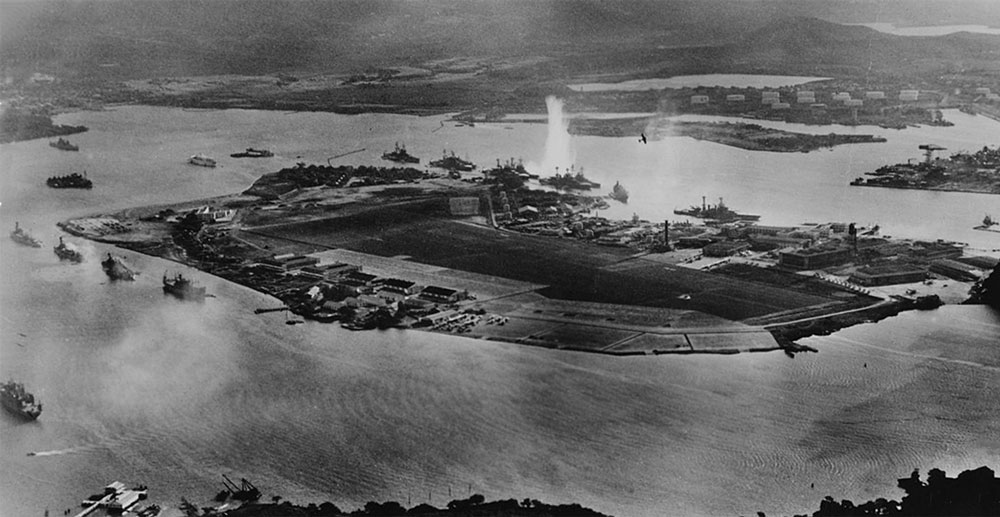
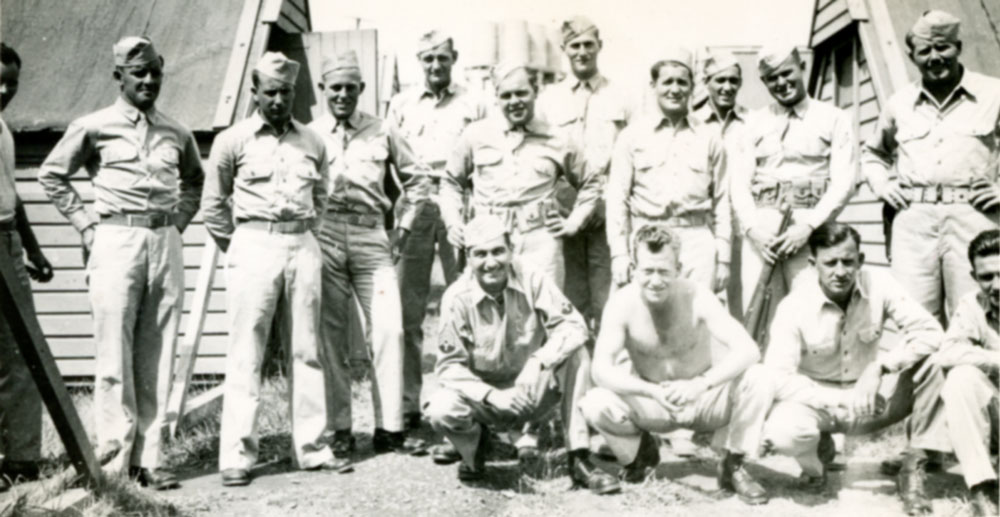

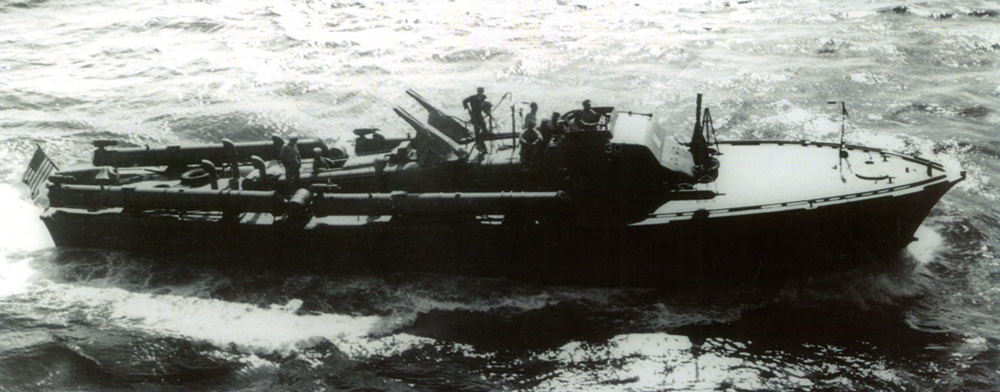
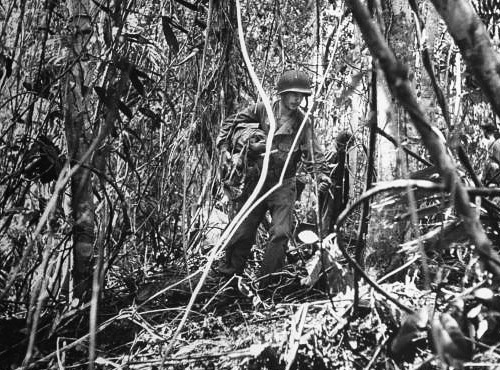
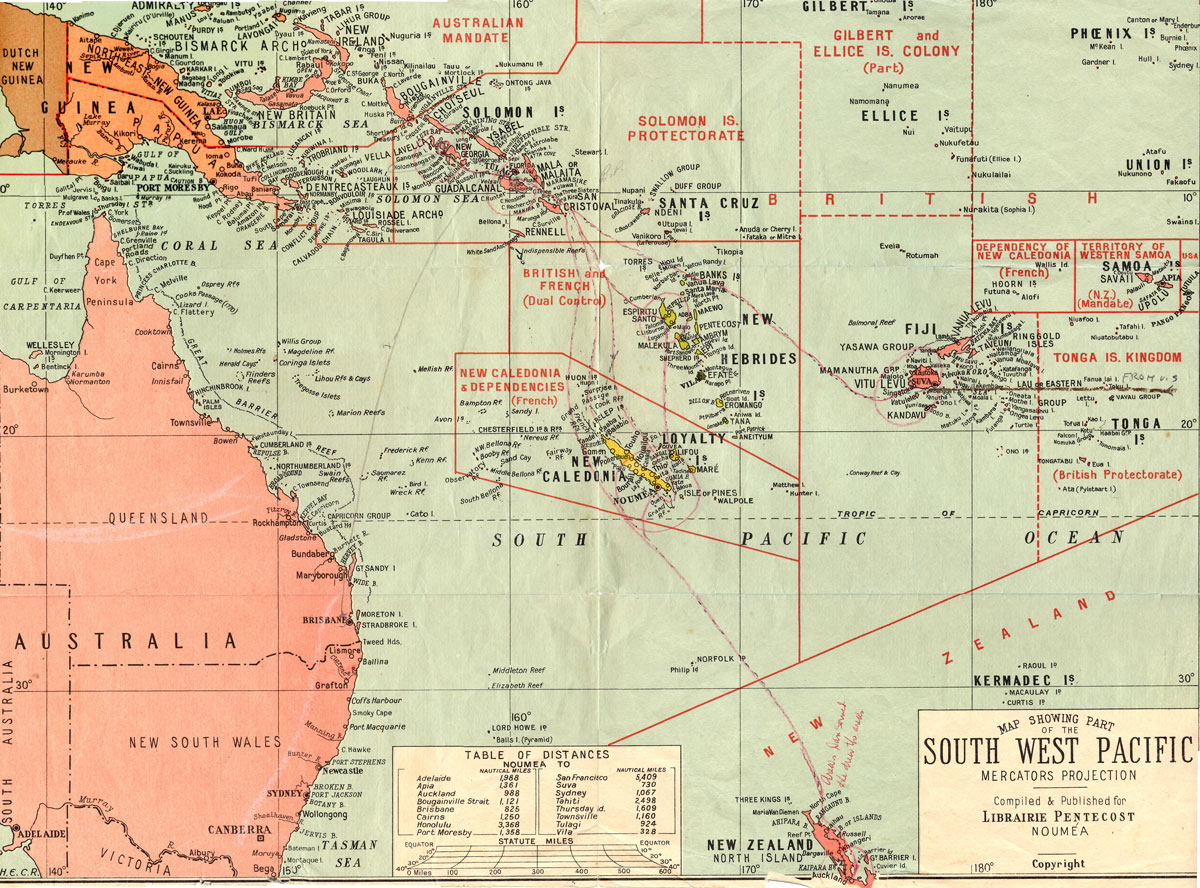
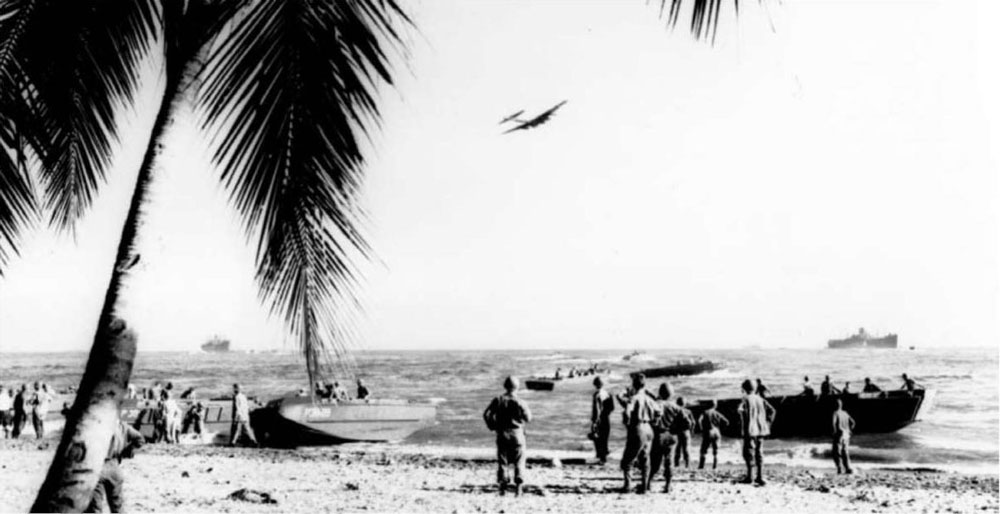
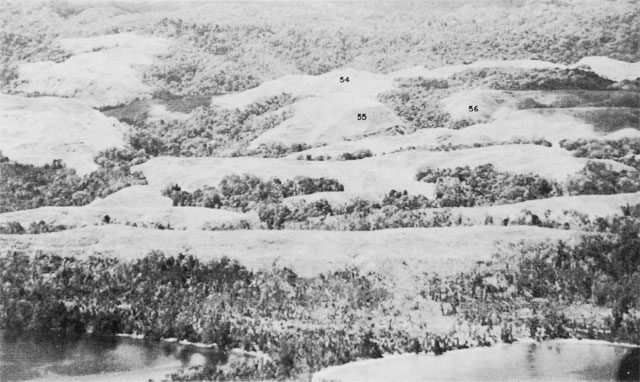

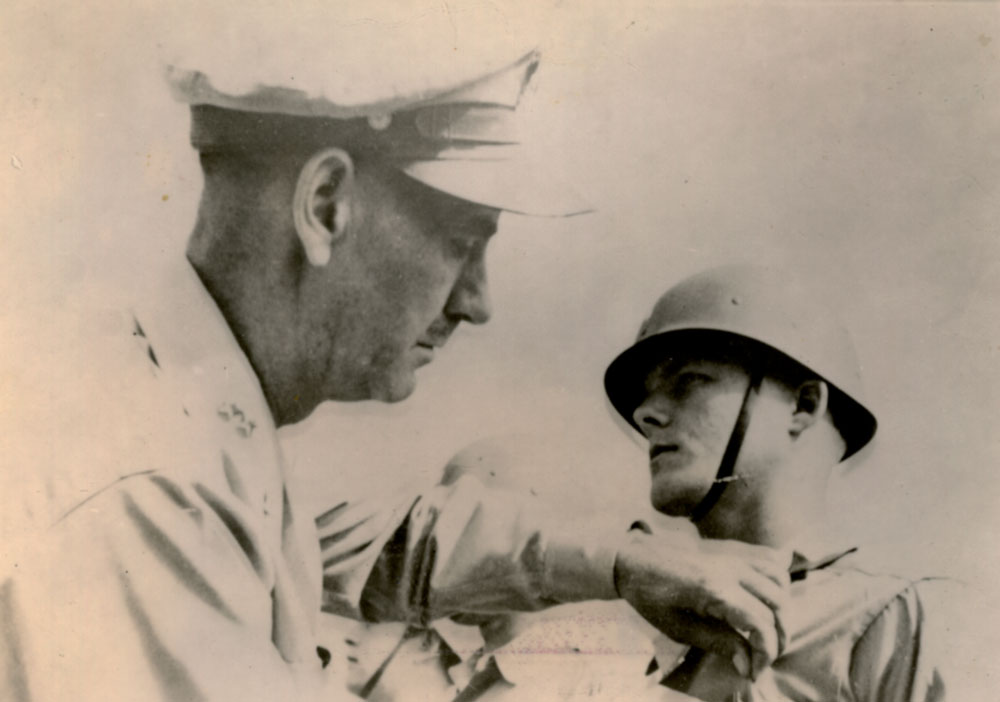
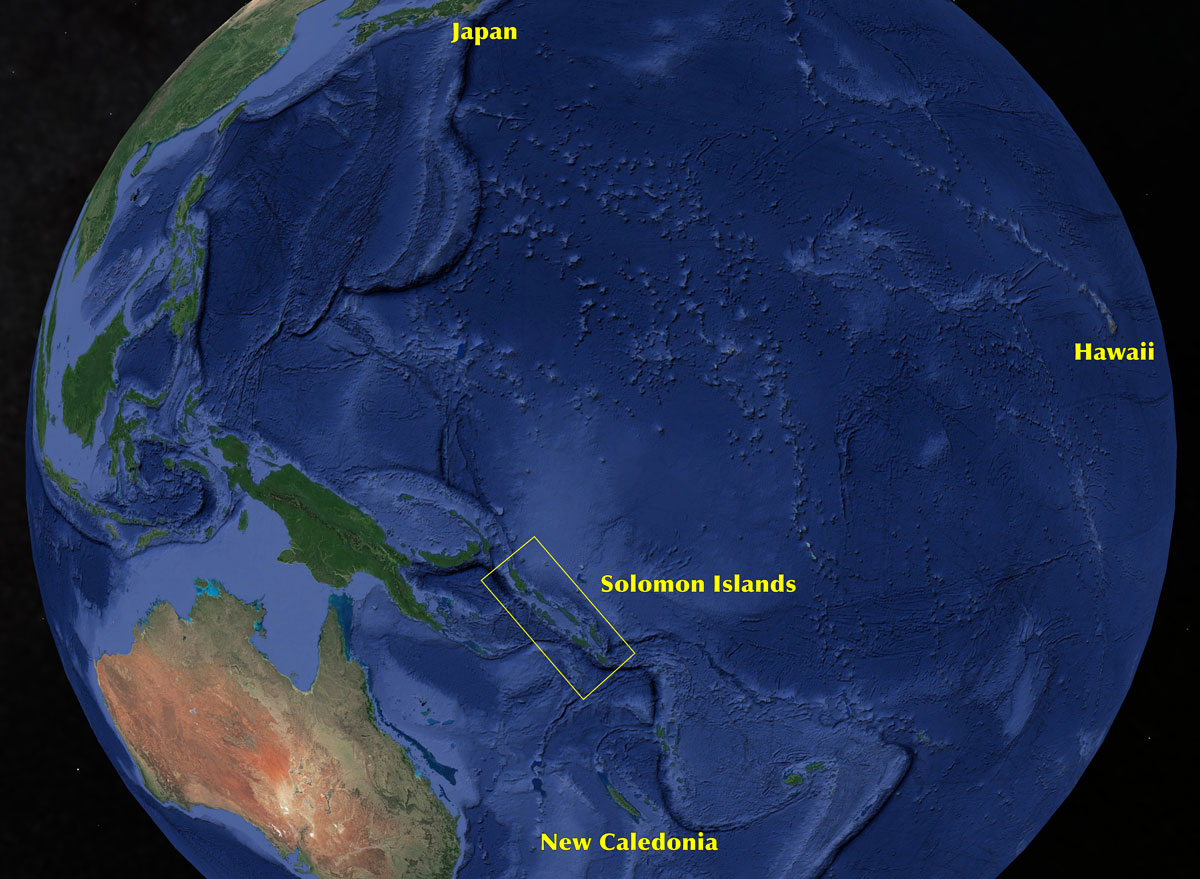
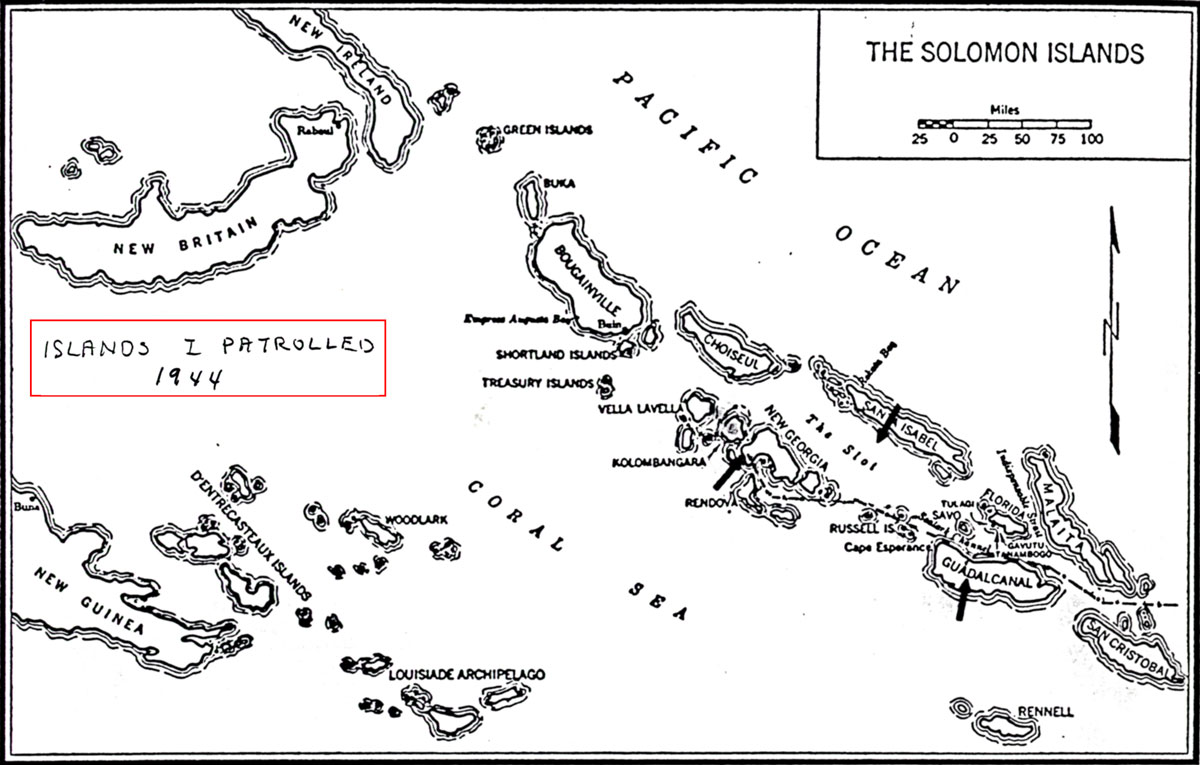
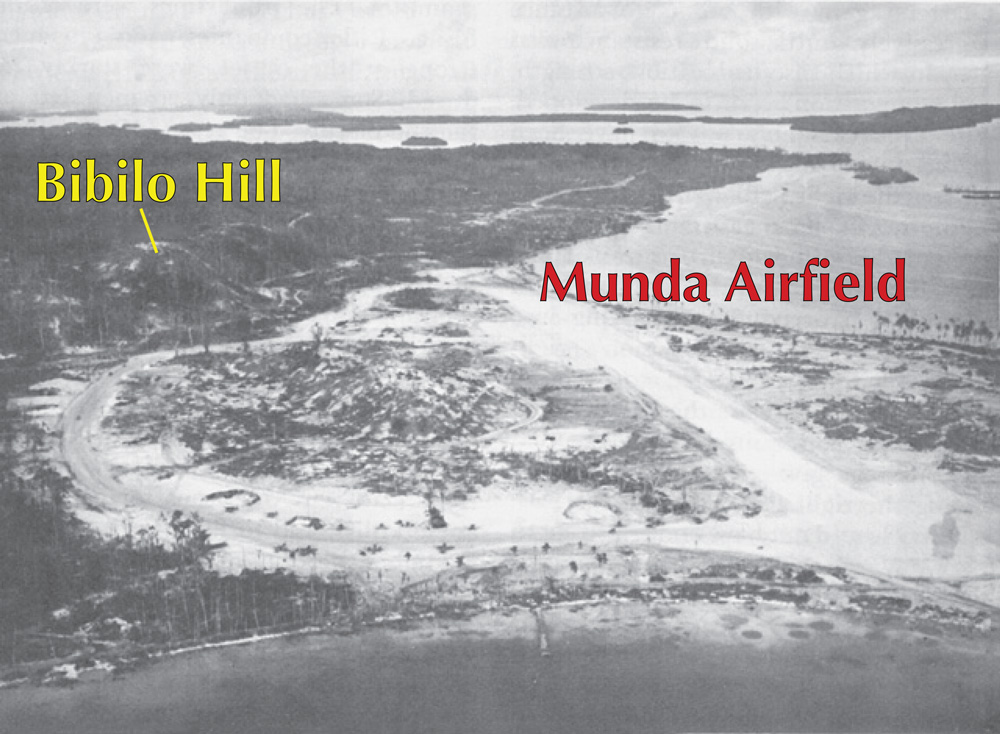
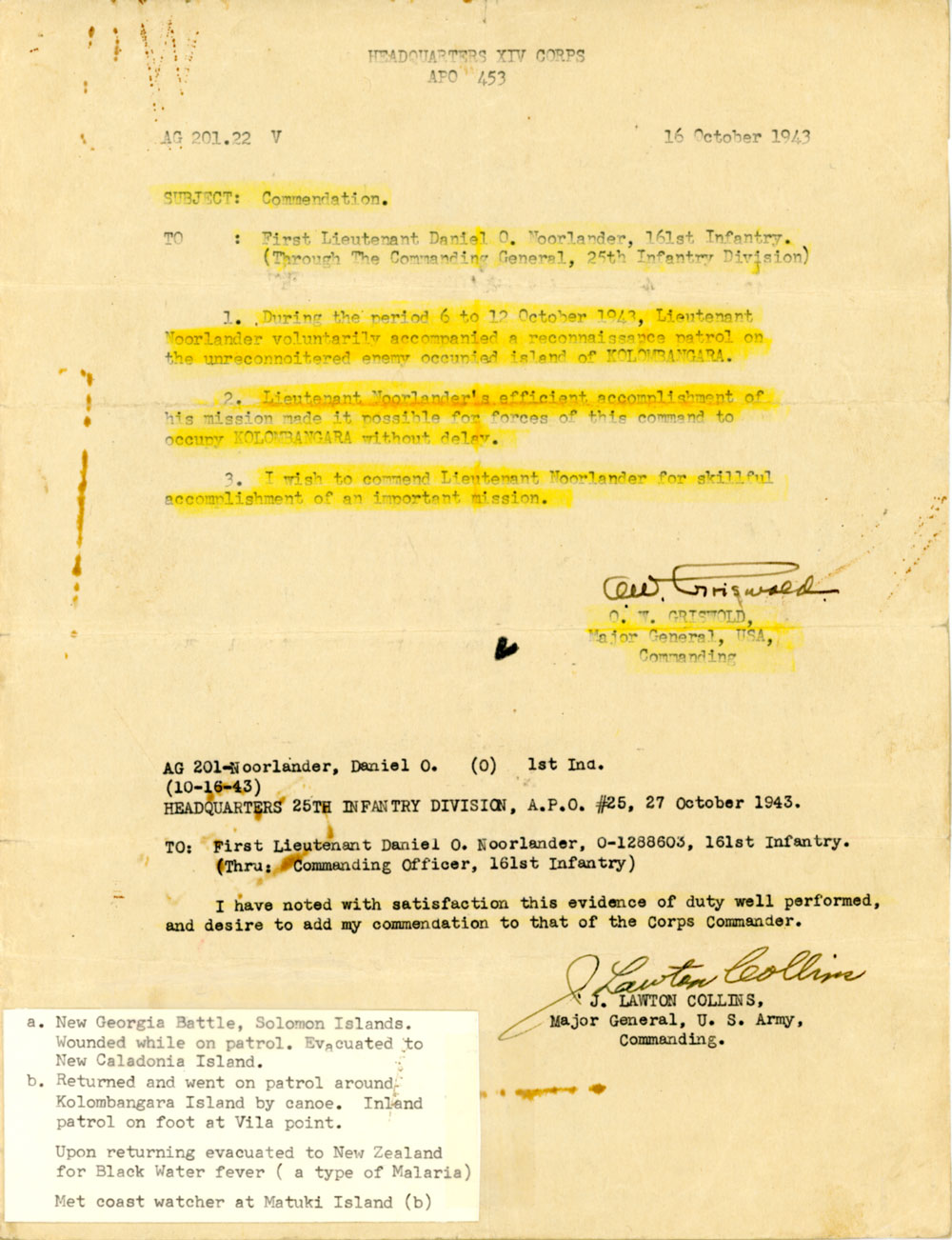

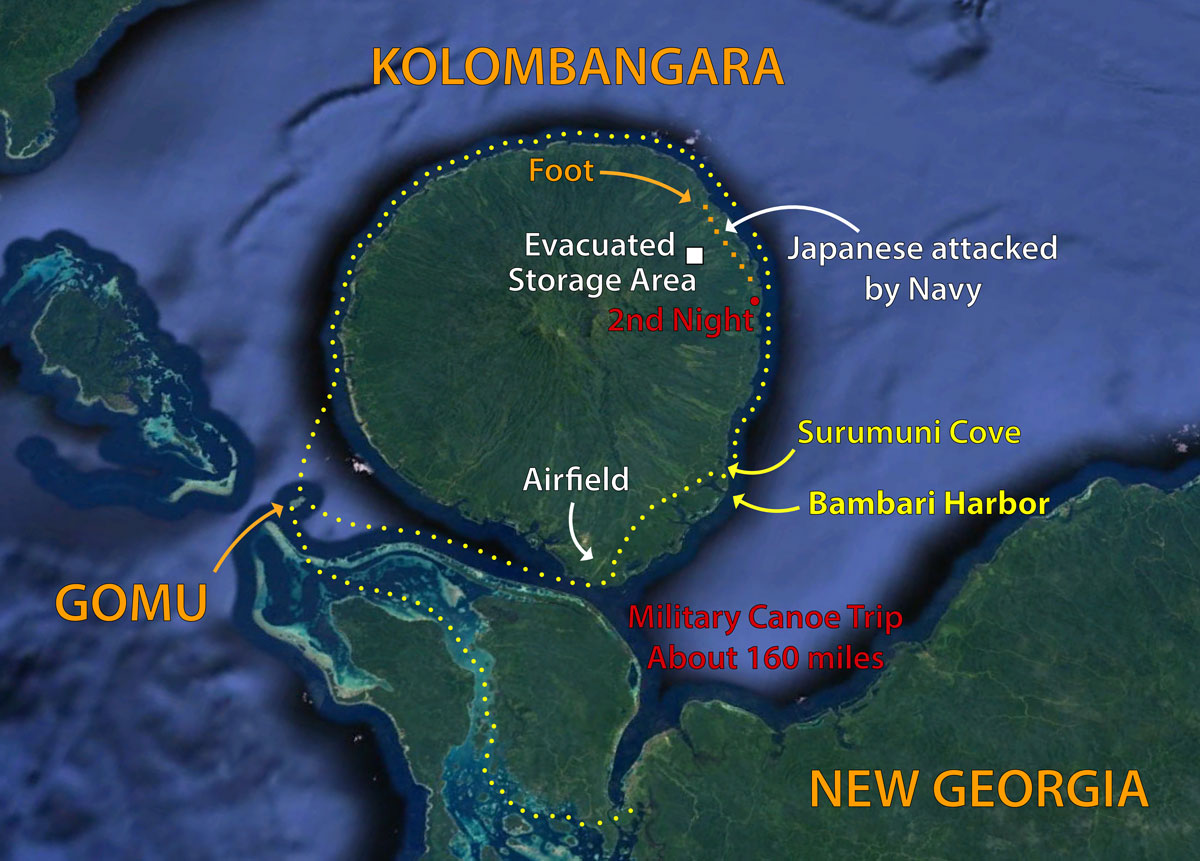
.jpg)
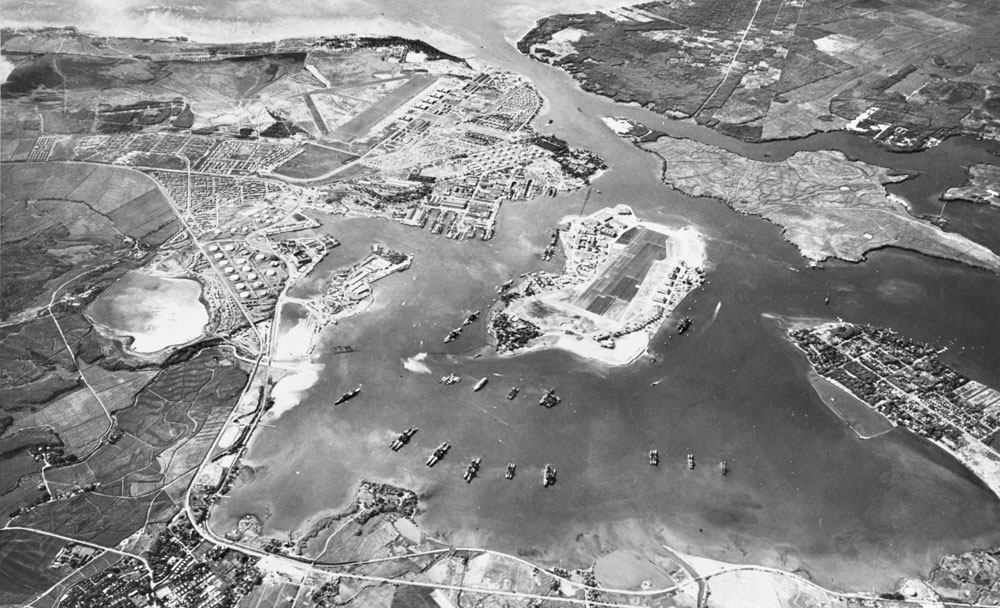
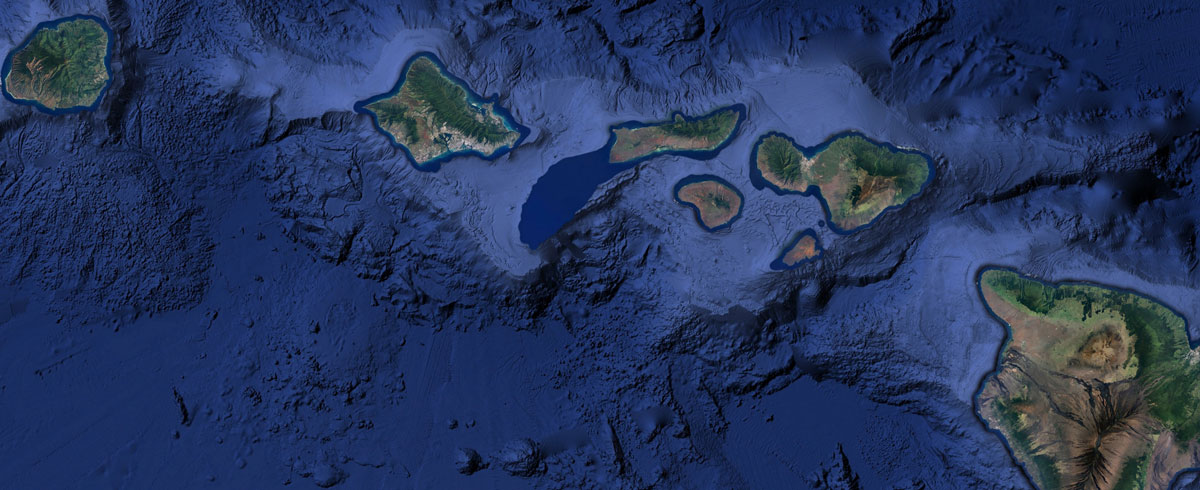
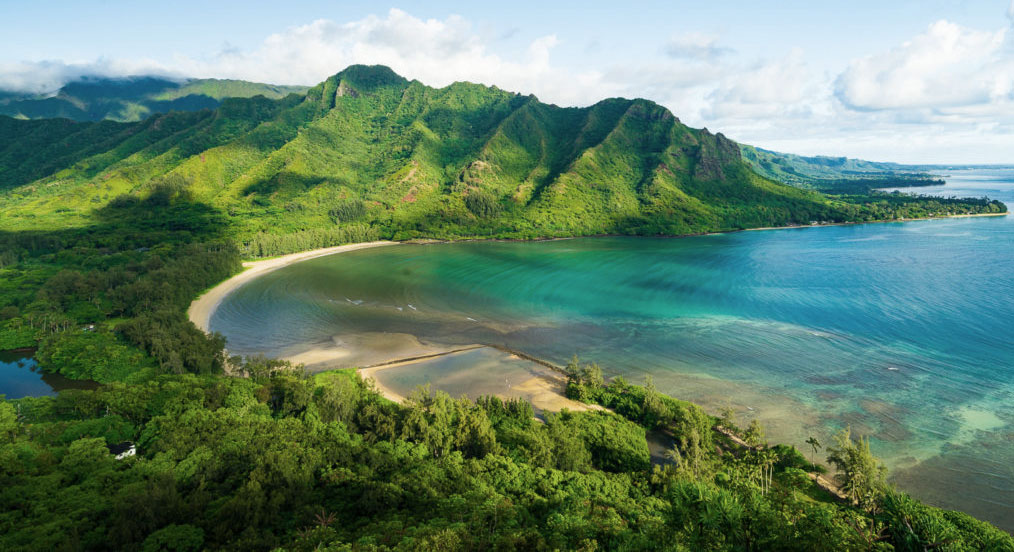
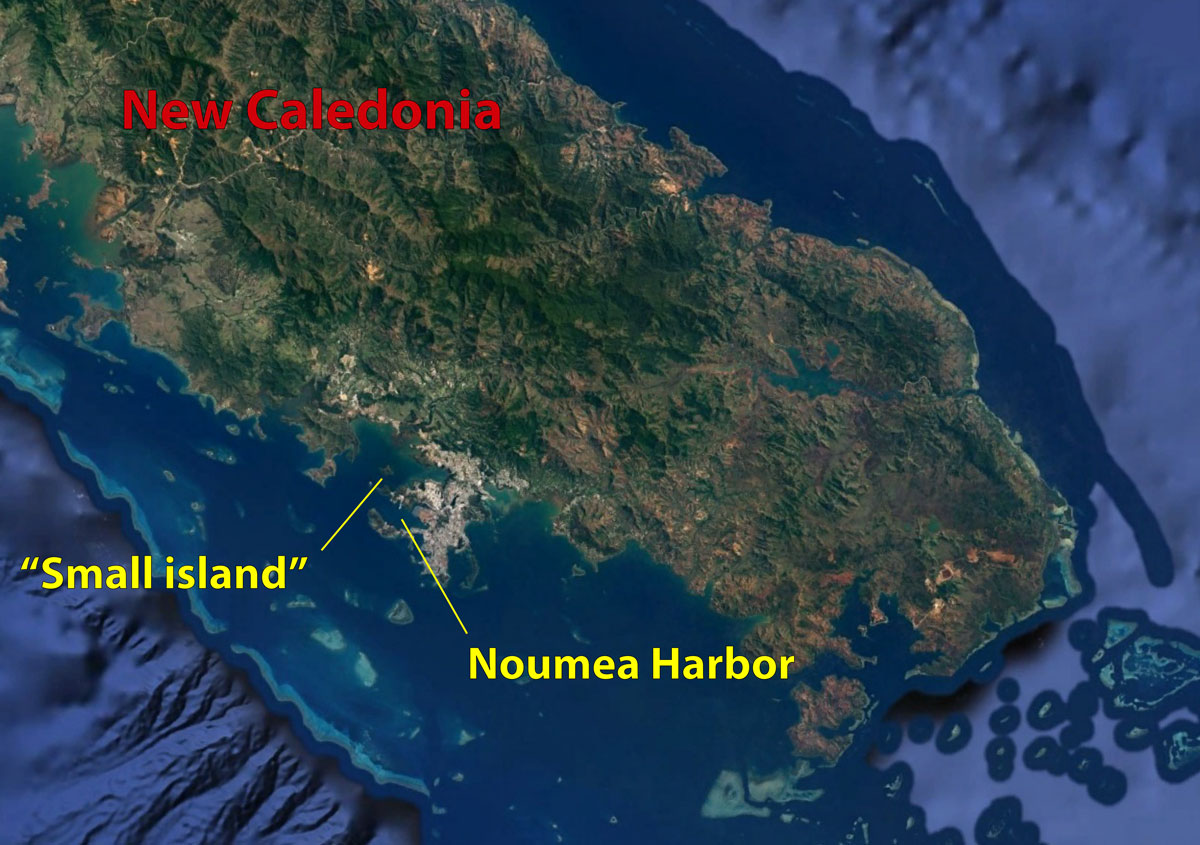

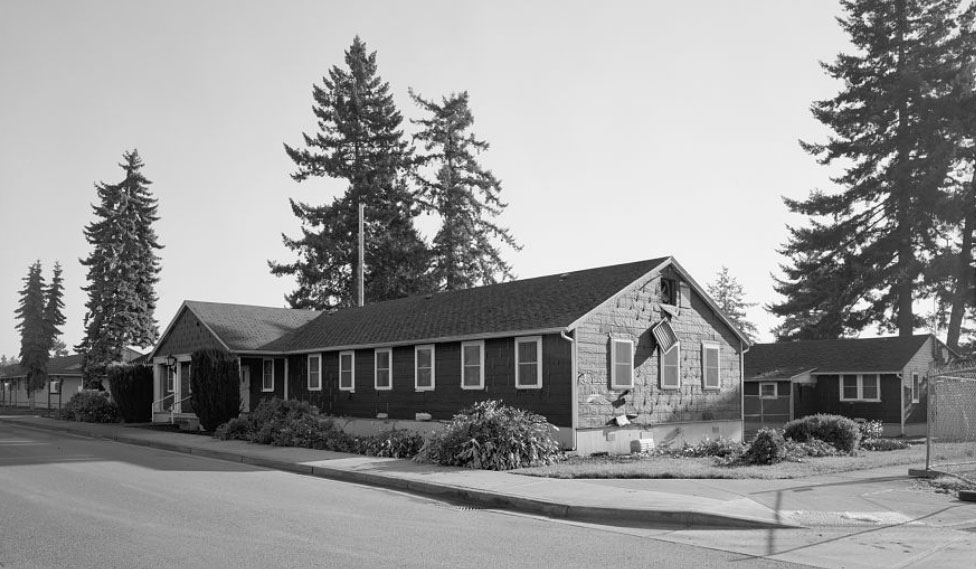
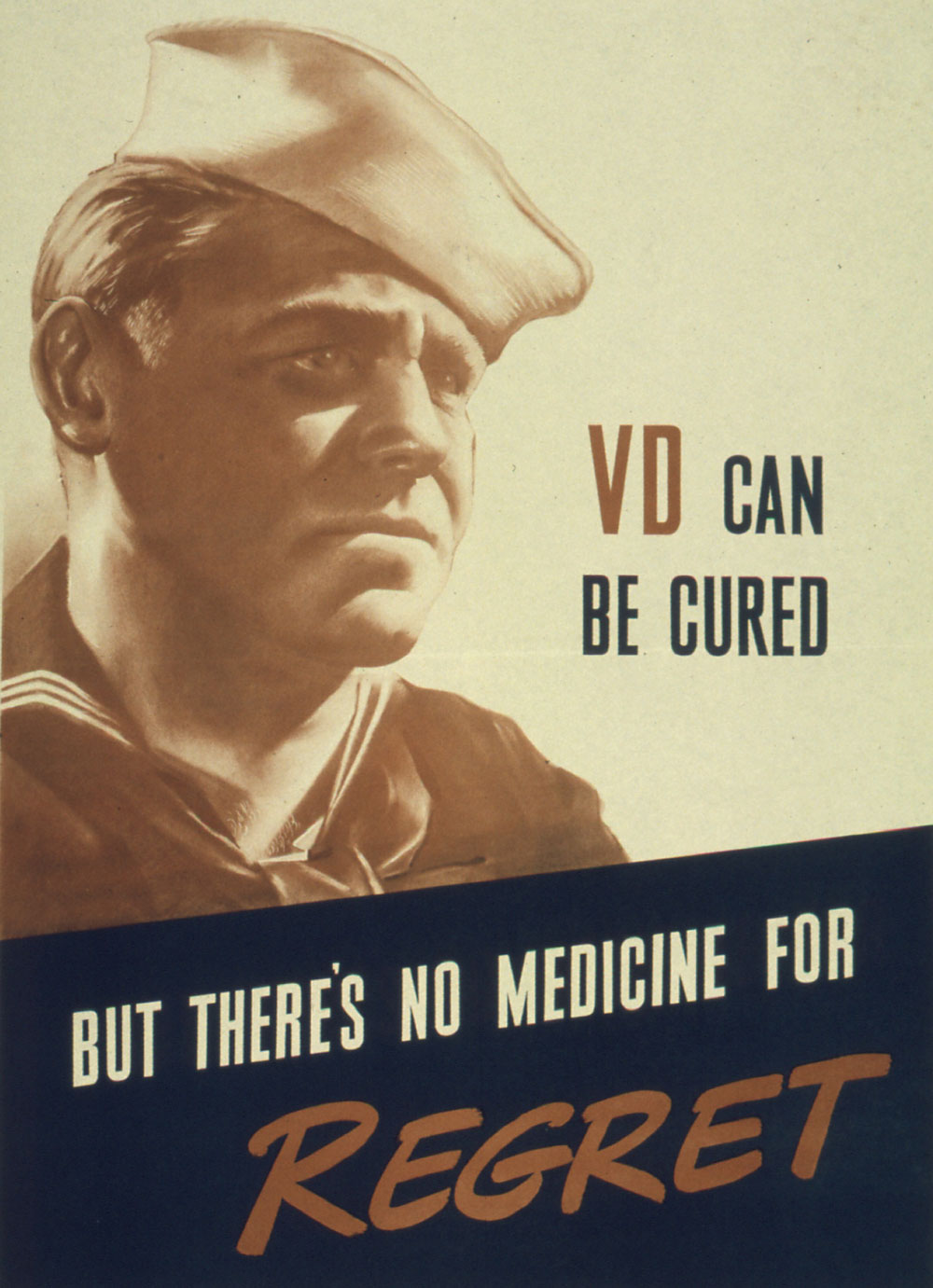
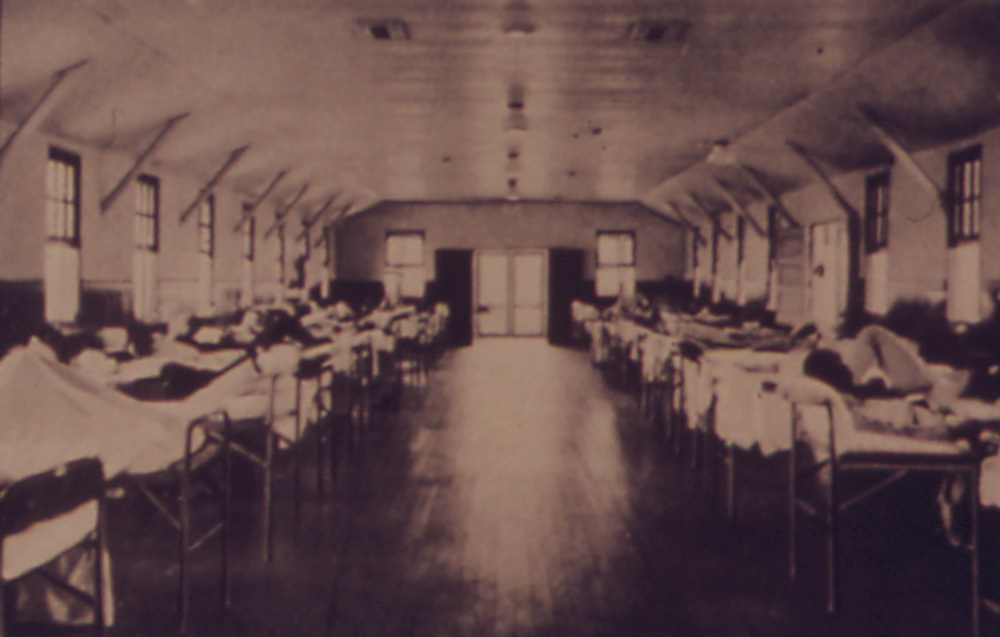
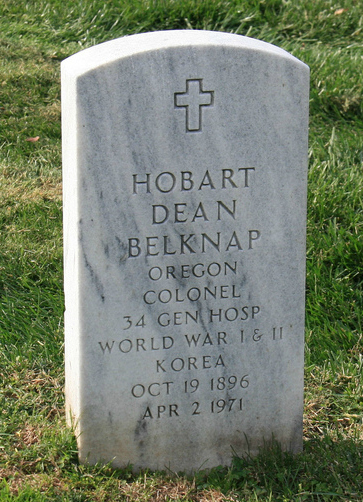

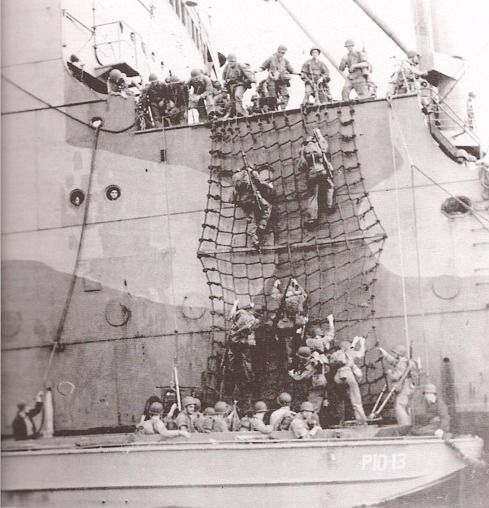
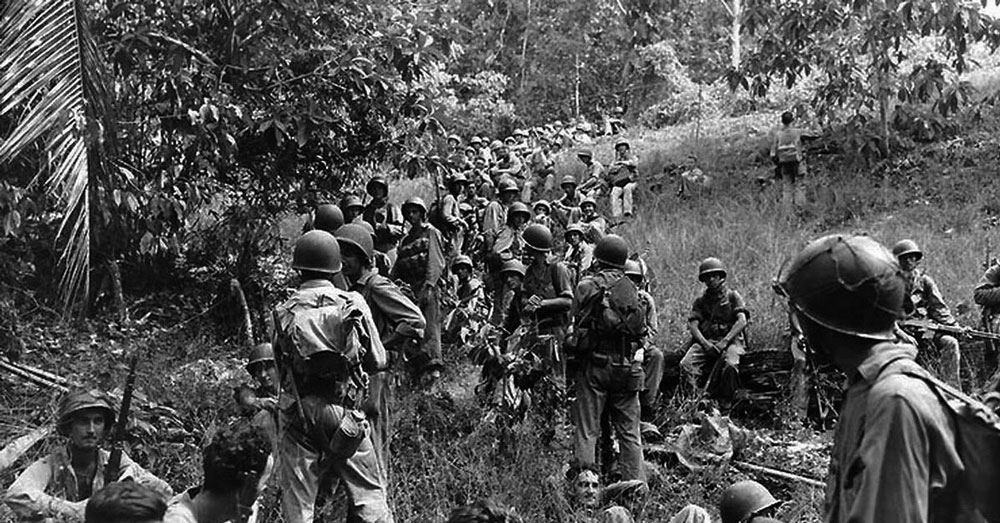
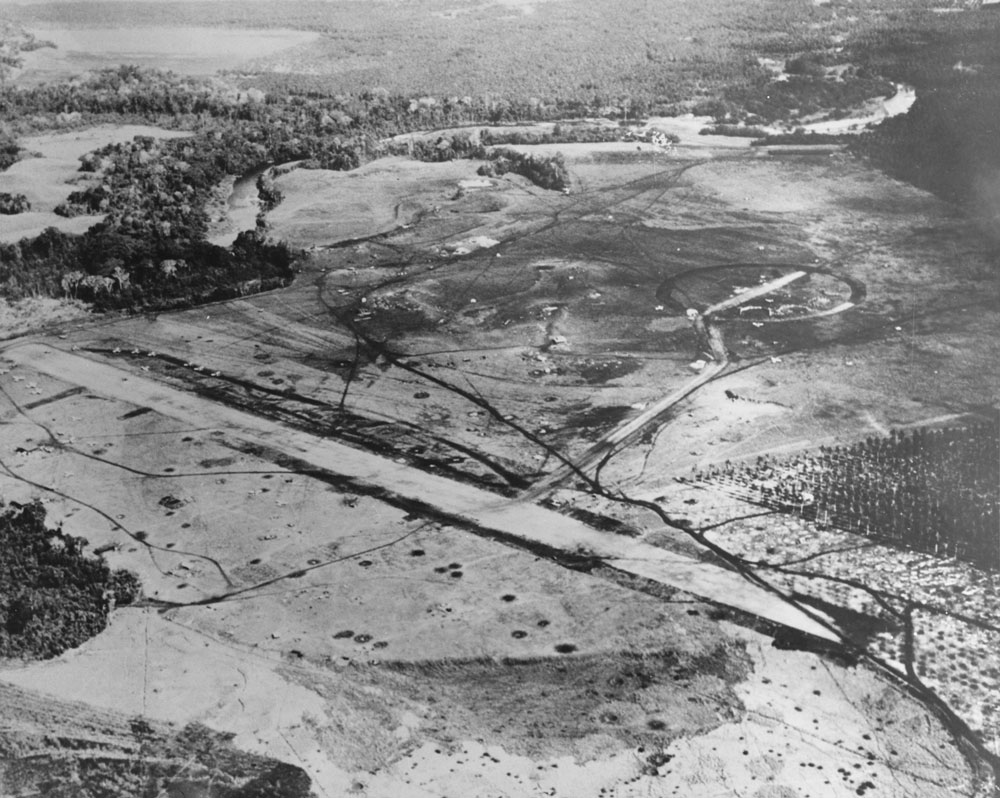

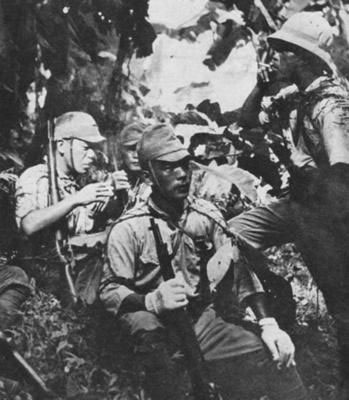

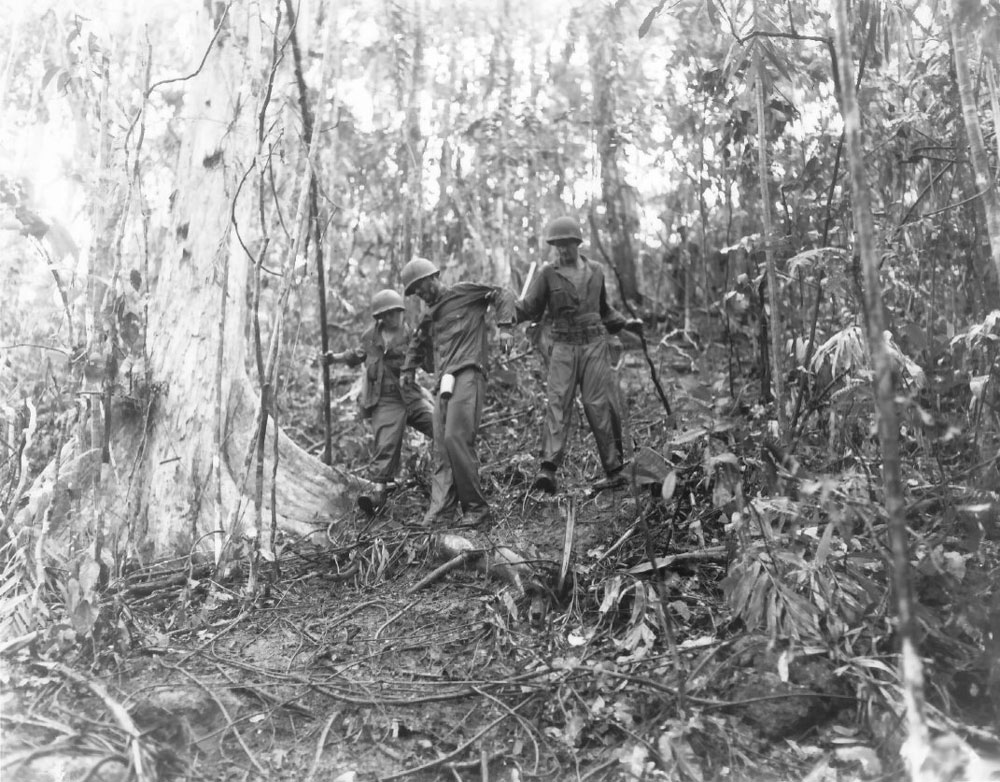
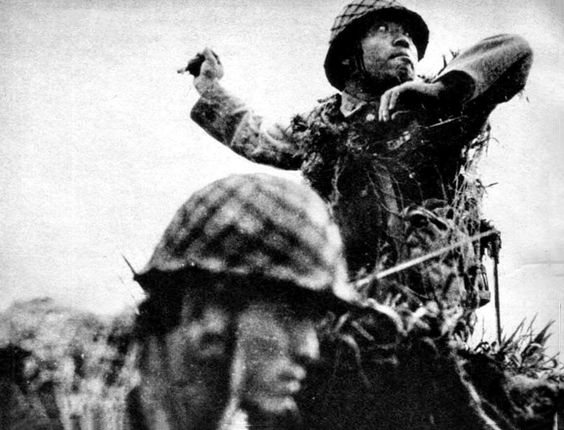
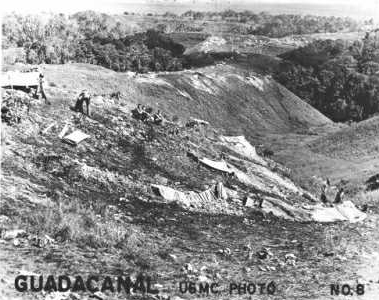
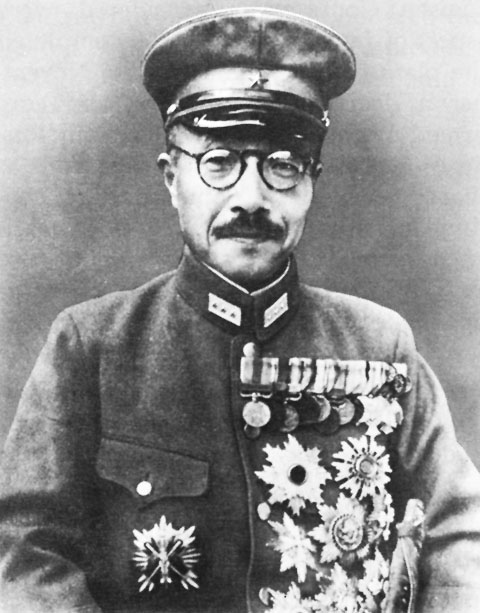

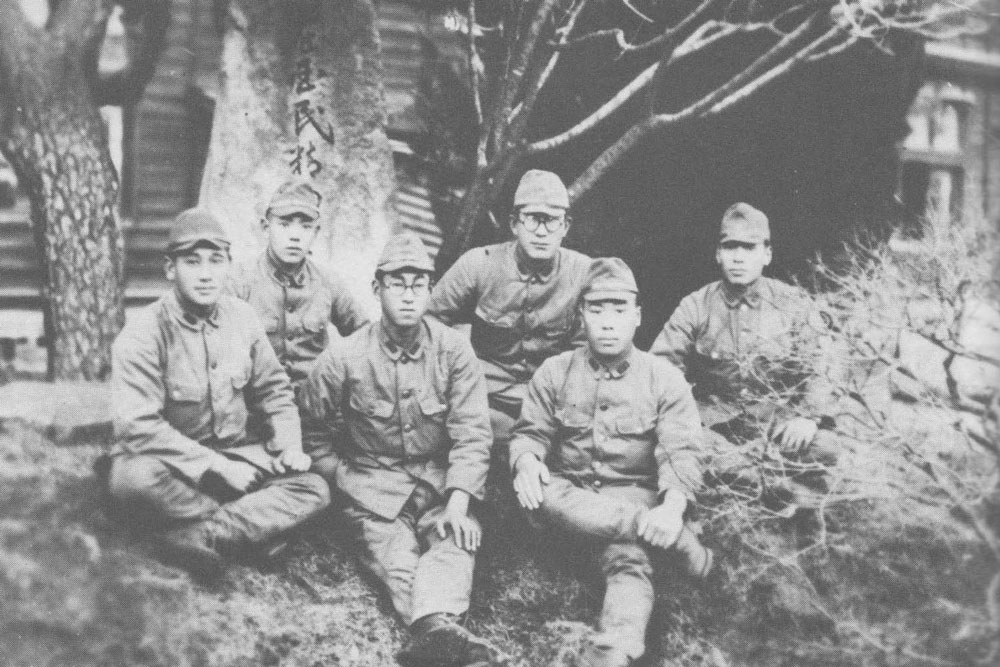
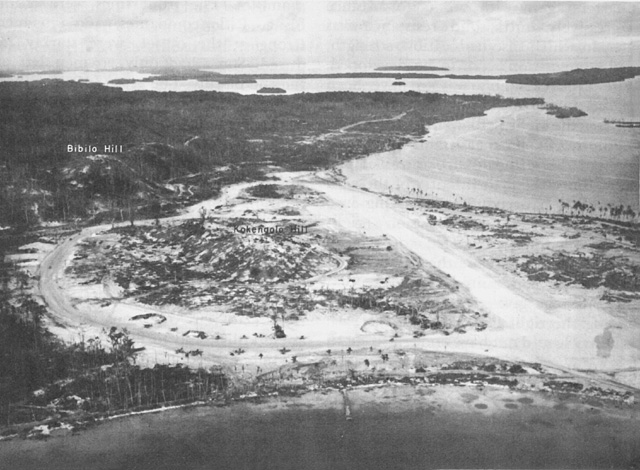
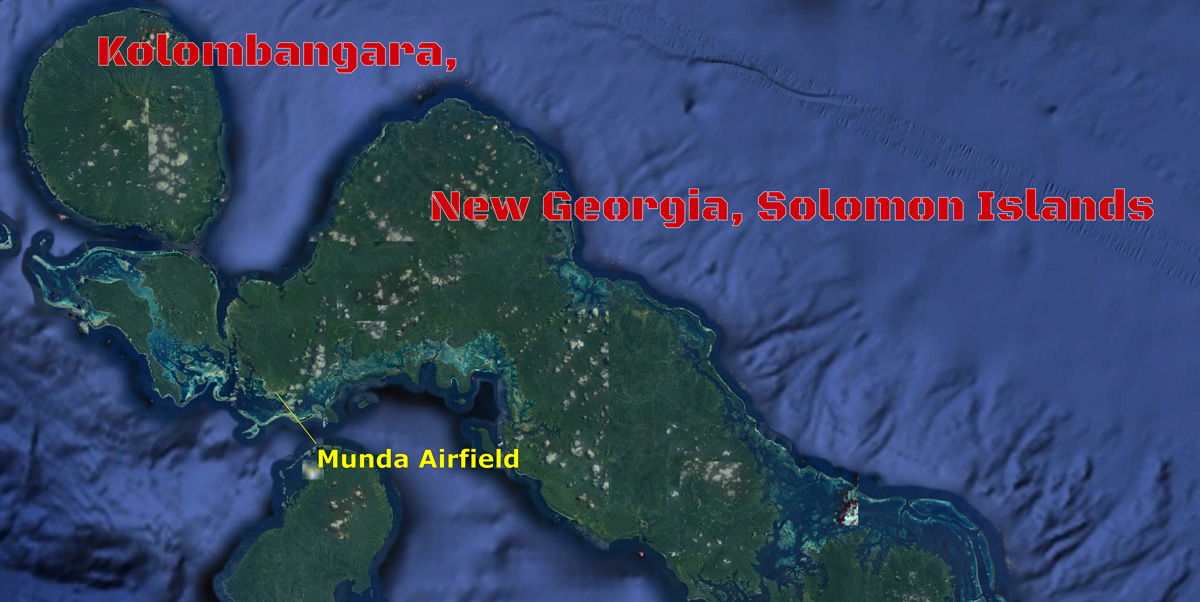

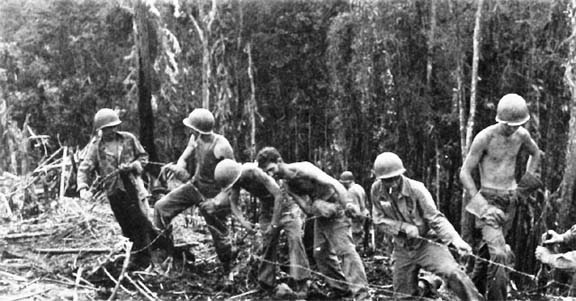
 ;
;

